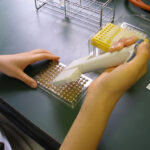Conference report
At the recent EW Nutrition Poultry Academy in Jakarta, Indonesia, Dr Steve Leeson, Professor Emeritus, University of Guelph, Canada, opened his presentation by stating that “it is obvious that any nutrient deficiency will impact bird health, but not so obvious is that nutrition per se can positively impact immunity and health in an otherwise healthy and high-producing bird.”
Modern high-performing broilers are characterized by extremely high feed intake. This puts a lot of stress on the physiology of the entire gastrointestinal tract, but particularly so on the absorptive epithelial cells of the small intestine. Any organism requires a nutrient source for survival and reproduction. Dr Leeson asked “can we significantly reduce nutrient supply to pathogens, while sustaining bird productivity?”
He reminded the audience that no cellular function comes for free: so there is always a “cost”. A general conclusion is that 10% of nutrients can be used for immune function during disease challenge, and always get priority. Therefore, you don’t want to overstimulate the immune system, which in extreme situations leads to an inflammatory response. In his presentation, Dr Leeson considered factors determining gut health and nutritional tools which are available to support gut health.
Gut microflora
Gut pathogens impact the bird and/or the consumer. Clostridia and E. coli are the major concerns regarding bird health and productivity, whereas Salmonella and Campylobacter are major pathogens important for human health.
The chick hatches with a gut virtually devoid of microbes, so early colonizers tend to predominate quite quickly. Microbial species present on the hatching tray, during delivery and during the first few days at the farm will likely dictate early gut colonization. In some instances, the chick’s microflora may be established by the time it gets to the farm, so the probiotic faces more of a challenge to establish itself as the predominant species.
Antibiotic alternatives
Gut villi development matures at around 10-15 days of age. The broiler pre-starter diet therefore is a target for feed additives that positively impact gut structure and development.
- Among the short chain fatty acids, butyric acid is considered the prime energy source for enterocytes and it is also necessary for the correct development of the gut-associated lymphoid tissue (GALT). Butyric acid can also be added indirectly via fermentation of judicious levels of soluble fiber to encourage optimal gut villi development. Dr Leeson added that he is a big believer in butyric acid, encouraging a good gut structure at 10 days, which can be worth about 50 kcal.
- Exogenous enzymes should also be considered in an attempt to maximize digestion and limit the flow of nutrients to the large intestine and ceca. Protease enzymes have great potential in this regard, since they allow nutritionists to reduce dietary crude protein and hopefully reduce the supply of nitrogen that fuels proteolytic Clostridia bacteria in the large intestine and ceca.
- Amino acids, particularly threonine, play a critical role in the maintenance of intestinal mucosal integrity and barrier function, especially for mucin synthesis, which protects enterocytes from adherence by pathogenic bacteria, and from attack by endogenous enzymes and acids.
- Polyunsaturated fatty acids (PUFAs) – Omega-3s and especially DHA from fish oil help to reduce inflammatory response (overstimulation). Omega-3s are poorly converted to DHA by the chicken, so conventional sources such as flax are of limited application for immunity.
- Blood plasma from pigs or cattle is a complex spray-dried mixture of proteins and amino acids, many of which are immunoglobulins that “temper” the immune system, much like PUFAs.
- Vitamins A, D, E and C have vital roles in the normal function of the immune system and have antioxidant capacity.
- Certain complex carbohydrates, such as ß-glucans, influence gut health due to their fermentation, leading to the production of short-chain fatty acids, such as butyrate.
- Antioxidants – to firstly control oxidation of fats and fat-soluble vitamins in feed, and secondly to optimize birds’ cellular oxidative capacity, to prevent cell damage, therefore maintaining healthy cellular and immune function.
- Betaine increases intracellular water retention, reducing “dehydration” of microvilli and increasing their volume/surface area.
- Fiber – moderate levels (1-2%) of soluble (fermentable) and insoluble fiber can be beneficial to early gut development by stimulating gizzard development and endogenous enzyme production.
- Phytogenics are becoming very common in combination with acidifiers (upper tract) and probiotics. Essential oils are becoming more mainstream the more we know about them.
Recommendations for optimizing gut health and immunity
Fast growth rate and high egg output are negatively correlated with immune response. Consequently, nutrient-dense diets are not optimal for immunity. With bacteria, it’s a numbers game – but these numbers quickly multiply. The first 7 days are important, therefore probiotics must be established early. Consider the role of targeted feed additives, such as butyrate, phytogenics, antioxidants, PUFAs etc.
Also, maximize feed particle size – the limit is usually pellet quality. Mitigate nutrient transition at any diet change. Review the supply of trace minerals, as there is a trend to lower levels of organic minerals. With all the factors that weigh into production performance, any support that can be rallied through nutrition needs to be considered.
***
EW Nutrition’s Poultry Academy took place in Jakarta and Manila in early September 2023. Dr. Steve Leeson, an expert in Poultry Nutrition & Production with nearly 50 years’ experience in the industry, was the distinguished keynote speaker.
Dr. Leeson had his Ph.D. in Poultry Nutrition in 1974 from the University of Nottingham. Over a span of 38 years, he was a Professor in the Department of Animal &Poultry Science at the University of Guelph, Canada. Since 2014, he has been Professor Emeritus at the same University. As an eminent author, he has more than 400 papers in refereed journals and 6 books on various aspects of Poultry Nutrition & Management. He also won the American Feed Manufacturer’s Association Nutrition Research Award (1981), the Canadian Society of Animal Science Fellowship Award (2001), and Novus Lifetime Achievement Award in Poultry Nutrition (2011).















